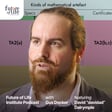Become a Creator today!Start creating today - Share your story with the world!
Start for free
00:00:00
00:00:01

Brian Toon on Nuclear Winter, Asteroids, Volcanoes, and the Future of Humanity
Brian Toon joins us to discuss the risk of nuclear winter.
Learn more about Brian's work: https://lasp.colorado.edu/home/people/brian-toon/
Read Brian's publications: https://airbornescience.nasa.gov/person/Brian_Toon
Timestamps:
00:00 Introduction
01:02 Asteroid impacts
04:20 The discovery of nuclear winter
13:56 Comparing volcanoes and asteroids to nuclear weapons
19:42 How did life survive the asteroid impact 65 million years ago?
25:05 How humanity could go extinct
29:46 Nuclear weapons as a great filter
34:32 Nuclear winter and food production
40:58 The psychology of nuclear threat
43:56 Geoengineering to prevent nuclear winter
46:49 Will humanity avoid nuclear winter?
Transcript
Introduction and Guest Introduction
00:00:00
Speaker
Welcome to the Future of Life Institute podcast. My name is Gus Stocker. If the world plunges into a nuclear conflict, one possible consequence could be nuclear winter, which is a global decrease in temperatures leading to a collapse of agriculture. On this episode, I'm joined by Brian Toon. Brian is an atmospheric scientist at the University of Colorado Boulder, and he has spent decades researching nuclear winter.
00:00:30
Speaker
We talk about how nuclear winter could happen, what the consequences might be, and how humanity could avoid this catastrophe.
Understanding Nuclear Winter
00:00:39
Speaker
Along the way, Brian has fascinating stories to share about asteroids, volcanoes, and what we might learn about nuclear winter from studying the extinction of the dinosaurs. I really enjoyed this conversation, and I hope you will too. Here's Brian Toon.
00:00:58
Speaker
Brian, welcome to the podcast. Thank you, guys. When did you begin working on nuclear winter? Well, I began in the early 1980s.
00:01:10
Speaker
at the time working for NASA. And I had done a lot of work on how volcanoes affect the climate. We were worried at that time about supersonic aircraft affecting the climate and various other issues about space shuttle engines. And about that time, the people at Berkeley discovered that an asteroid collision had killed a dinosaur 66 million years ago.
00:01:36
Speaker
And so I started working on that problem. And there's a layer of material all around the earth left from that collision. You can put your finger on it if you want to, and various platens about a centimeter thick. And it's full not only of asteroidal material, but also smoke.
Asteroids, Volcanoes, and Geological Theories
00:01:56
Speaker
And so there's 66 million year old smoke covering the earth from 66 million years ago.
00:02:04
Speaker
And in order to make all that smoke, you had to basically burn everything on the surface of the planet, all the trees, all the grasses, and probably even some of their roots, things underneath the surface soil. And a very controversial idea that an asteroid impact had killed the dinosaurs.
00:02:23
Speaker
violating basic geological ideas of uniformitarianism. So geology, hundreds of years ago, had been dominated by religious dogma and floods from Noah and things like that. And the geology community had eventually
00:02:44
Speaker
shown that most of the things we see like mountains and oceans and things like that have just evolved very slowly. And so it's hard to see it in a human life, but everything is happening now and it just accumulates over long periods of time. So they were very opposed in geology to any catastrophic
Nuclear Weapons and Catastrophic Effects
00:03:03
Speaker
pointed to you like an asteroid killing the dinosaurs. It went back to this religious thing where catastrophes were like God flooding the earth and Noah surviving the dark. But actually these asteroid collisions are not sudden events. They are constantly going on. There's about 40 tons of debris falling into the earth every day.
00:03:27
Speaker
mostly in tiny little particles. Asteroids are constantly bombarding the planet. There was a big explosion, a 400 kiloton explosion over in Russia a few years ago that injured a thousand people. That was an object about 20 meters in size, a fifth of a football field or something. So it wasn't every big asteroid, but things like that occur very
00:03:57
Speaker
few dozens of years somewhere in the Earth. And in fact, there's a Hiroshima-sized explosion in the Earth's atmosphere every year or two from incoming asteroids. When we go back in history to bigger and bigger events, the moon was formed from an asteroid collision with the Earth. And in that case, the asteroid was a little bit bigger than Mars.
00:04:20
Speaker
But at any rate, I gave a talk about this just after the discovery of the asteroid Gilliganosaurus, explaining how it happened and how they died from all this debris being put into the atmosphere, which at that time we thought was rocks from the asteroid. We didn't realize there was all this smoke there for quite a few years.
00:04:42
Speaker
At any rate, someone at this meeting said, well, what about nuclear weapons? They put a lot of stuff in the atmosphere. You should go think about those. So I called up a friend of mine, Rich Cherko, and said, hey, Rich, maybe we should think about nuclear weapons again. We thought about him before and hadn't really found anything, but we
00:05:03
Speaker
Spent more time at it. We thought, wow, all the dust raised from these nuclear explosions could do something. And then we came across some paper by Hall Crutzen and John Burks pointing out that cities would be set on fire.
00:05:19
Speaker
By nuclear weapons exploding and rich happened to work for a company that knew a lot about this because they studied fire some nuclear weapons. So we decided we should look into the smoke from the burning cities.
00:05:34
Speaker
So Krutzen and Burks had suggested that there would be forest fires set by nuclear bombs going off.
Mass Extinctions and Food Supply Risks
00:05:40
Speaker
So a nuclear weapon going off is like bringing a piece of the sun down to the earth. You know, it's the same kind of thing. The sun produces its light from thermonuclear explosions, basically fusion reactions in its core. And so we're bringing a little piece of the sun down to the earth and
00:05:59
Speaker
When the nuclear weapon goes off, there's a bright burst of light. And it's very intense. And it can start fires out at a considerable distance.
00:06:10
Speaker
something very energetic explodes and lights a bunch of fire where from smoke rises that blocks out the sunlight coming to Earth. Exactly. And that mechanism is shared between the asteroid impact that killed the dinosaurs and a potential catastrophe scenario of nuclear winter.
00:06:30
Speaker
That's exactly right. So from the science point of view of studying nuclear winter is you can't do any experiments. You certainly don't want to do anything. And so you have to go look for natural analogs. And the extinction of the dinosaurs is a natural analog because
00:06:50
Speaker
You had an immense global fire there, put a huge amount of smoke into the atmosphere. The fires probably killed the dinosaurs and the smoke black sunlight temperatures fell, but the oceans had mass extinctions. It wasn't just the dinosaurs. 75% of the species on the planet that we know about perished.
00:07:11
Speaker
And they see that probably very suddenly within a decade or so, or less. So in the oceans, the light went out, photosynthesis stopped, so plants couldn't produce any more food in the oceans. And so the fish and zooplankton, which ate the phytoplankton, starved to death.
00:07:37
Speaker
And so this is a very definite parallel with what would happen after a nuclear war. How long did it last? Do we know how long it lasted?
00:07:46
Speaker
Well, it's hard to tell from the geological record there about the closest you can tell is that from dating the record is about 50,000 years, which is not anywhere near the time scale that this happened on. So we know there's this layer that I mentioned covering the whole earth. And we know how big the particles are in that layer.
00:08:09
Speaker
And they all fell out of the atmosphere within about a year or two, perhaps extending as long as a decade. So we think the whole thing that killed the dinosaurs and the phytoplankton and the fish in the oceans and
00:08:25
Speaker
extinct of all kinds of plants in the land and other animals as well. The whole thing probably only took about 10 years to occur. So this is something that most people are familiar with. You have to eat every day. Maybe you could go for a week or two without starving to death.
00:08:43
Speaker
But, you know, you have to keep consuming food. And if the food supply is suddenly eliminated, you're in big trouble. And a potential nuclear winter would take about as long, about a decade. Yeah. So this nuclear winter is... So let's start again on how this happens. If you take two big pieces of uranium, the right type, and you stick them together, they'll blow up.
00:09:10
Speaker
And so the simplest bombs, which were built in the Second World War, were nothing more than shoving two pieces of uranium or plutonium together and the human blow up. Current weapons use fusion instead of fission. But you still get a lot of the energy just out of the uranium or plutonium that's in the bomb.
00:09:35
Speaker
So this is ENC squared, you know, which Einstein discovered. You take a little bit of mass from from these elements and convert it into energy and you can release a tremendous amount of energy that way. So this starts fires when the explosion occurs and of course it blows buildings down and radiates people with energy particles of light to kill them.
00:10:04
Speaker
And so there are a bunch of terrible things that happen if you're near ground zero.
00:10:08
Speaker
But the one that covers the biggest area is the fires. And so if you looked at a picture of Hiroshima after the bombs dropped in Japan, I had in the Second World War, you see this huge debris field. And that some of it is because the blast broke some buildings down, but most of it is because there was a huge fire there. And the fire actually released a thousand times as much energy as a bomb exploding did.
00:10:39
Speaker
So it's hard to imagine how powerful these big fires are. There are photographs of the bomb. You can see the mushroom cloud everybody's familiar with after a nuclear explosion. And a few hours later after that, gone away, there's a huge pyro cumulus. So we call them fire thunderstorms.
00:11:02
Speaker
We're singing trickily now in just fires and forests. We're having all these fires all over the world. And in 2017, there was a pyro cumulus in British Columbia from a big fire. And right around the new year, 2020, there was a set of big fires in Australia that had these big pyro cumulus, big fire thunderstorms.
00:11:28
Speaker
And these are important because they take the smoke from burning a forest and push it up to high into the atmosphere into what we call the stratosphere. But if you put smoke into the stratosphere, carry it up in these thunder firestorms, the smoke is in a place where it never rains. It never rains in the stratosphere. And so the smoke can stay there for years.
00:11:57
Speaker
And another thing that was suggested in the 1980s would be that the sun would shine in the smoke, which is very black. You see a fireplace or something like that, or you go out in places, burn, you see other black stuff all over the place, you know, just elemental carbon, so like charcoal. And the sun shines on that, it warms it, and heats it, and that heats the air, and it rises.
00:12:22
Speaker
And in the models from the 1980s, the smoke rose to the top of the models, which wasn't very high, didn't have good computers in the 1980s. But later work in the 1990s and their computers are better in the 2000 era and the smoke was rising up to about 80 kilometers.
00:12:42
Speaker
above the ground, so very, very high. And surprisingly, we actually observe this now in the 2017 and 2020 after these big forest fires, the smoke was put in just at the lower part of the stratosphere, about 12 kilometers above the ground. And the sun was shining on that smoke and heating it. And after a week or two, it rose to 20 or 30 kilometers.
00:13:09
Speaker
That altitude was limited because there wasn't very
Survival and Human Evolution
00:13:13
Speaker
much smoke. It was just a forest fire. But it did the same thing. These models are predicted 20 years earlier. And we saw the smoke hang around for 20 a year from satellites.
00:13:30
Speaker
So we could observe this very well and it did all sorts of other interesting little things in the stratosphere like quickly spread itself out over the earth. So it didn't just hover over the fires. It became a hemisphere for global phenomena very quickly.
00:13:45
Speaker
just as the models predicted. So the models are confirmed, in a sense, by the natural events that are analogies for what would happen if nuclear bombs went off. Exactly. What about the energies involved? How should we compare the energy involved in an asteroid impact or volcanic eruption with the energies involved in nuclear weapons? Is the right comparison between the energies involved with the
00:14:13
Speaker
fires that follow a nuclear war, or the setting of a nuclear weapon, or is the right comparison between the energy directly involved in the nuclear weapon explosion itself.
00:14:27
Speaker
Well, that's a good question. And the first point I think is that energy is what counts here. An asteroid's energy is what counts. And the energy goes like the cube of the size. So a one kilometer asteroid compared to a 10 kilometer asteroid, which is what killed the dinosaurs,
00:14:47
Speaker
the 10 kilometer asteroid has a thousand times as much energy. So that's why it was so important is because there's so much energy. Nuclear weapons, so the energy of the largest nuclear weapons in arsenals was about one megaton.
00:15:11
Speaker
1 million. It's equivalent energy of a million tons of conventional explosives. So you can imagine trying to put a million tons of explosive on an airplane. That's not going to happen. That's why nuclear weapons were developed. In the Second World War, we were bombing cities indiscriminately. That's how the war was fought.
00:15:30
Speaker
was incendiary bombs on cities. And it took hundreds and hundreds of airplanes to carry bombs over and burn Dresden to the ground and Hamburg and 60 Japanese cities were firebombed in the Second World War and largely destroyed by fires. But, you know, you find hundreds of airplanes out there or somebody's going to get killed in the airplane crash.
00:15:54
Speaker
And so one airplane could carry a nuclear weapon and release the energy. For example, the Hiroshima bomb was 15,000 tons of explosive energy. So one airplane could easily carry that bomb, but it would take fleets of them to carry anything like 15,000 tons.
00:16:16
Speaker
So that's what nuclear weapons were built to do, destroy cities. They're indiscriminate city killers. And that was their purpose. But going on to this comparison of volcanoes, bombs, and the asteroid, so a really large nuclear weapon would have one megaton of energy.
00:16:38
Speaker
The asteroid that killed the dinosaurs was in the millions of tons of energy. So it's equivalent to millions of nuclear weapons going off. And at least the fires or a volcano, a really big volcano, actually could have an energy of a megaton or more.
00:17:01
Speaker
Like we just have the Honga Tonga eruption here last year in Tonga, which created sound waves that were heard around the world and hurled material pretty high in the stratosphere. That eruption was comparable to a large nuclear weapon in terms of energy release. But if we look at what really matters to the climate, it's the amount of this black carbon that's put into the atmosphere.
00:17:30
Speaker
And in a nuclear war, say between Russia and the United States, we believe that about 150 million tons of black carbon could be put into the stratosphere, 150 million tons. And that sounds a lot, like a lot.
00:17:53
Speaker
But out of the asteroid, we think put in 15,000 million tons of black carbon. And we know that because it's still there. It's in this little layer and you'll put your finger on. So we know how much black carbon was put there. And as I said, you'd have to burn everything in the Earth service to produce that much black carbon.
00:18:17
Speaker
The asteroid event would be an extreme version of what would happen in the case of or in the event of a nuclear war between US and Russia.
00:18:26
Speaker
If you go down, so we've got 15,000 a million tons and 150 million tons. So the largest nuclear war is about 1% as much black carbon. So after the asteroid hit the planet, we think the amount of light still reaching the surface of the planet was about as much as a moonless night.
00:18:55
Speaker
The light levels there were 100 million times lower than normal. So going from a forest fire in Canada up to a nuclear war, you're going up by a factor of 1,000, and going from that to the asteroid, you're going up another factor of 100. So we know what happens on either end of a nuclear winter.
00:19:17
Speaker
to go down from a nuclear winter by a thousand. Well, you get some interesting phenomena that a few weird scientists are tracking and following, and they can see things happening, but the average person is oblivious to it. But if you go up by a factor of 100,000 from a fire in Canada, you cause the extinction of the dinosaurs and extinction of the oceans. The nuclear war is in the middle there somewhere.
00:19:42
Speaker
It's amazing that lives even continued after the asteroid impact 65 million years ago. Well, yeah, it may have been fortunate that more creatures were not extinct. When you take mammals, for example, we're mammals. And mammals had been on the planet almost as long as the dinosaurs had both originated after another mass extinction event about 250 million years ago.
00:20:11
Speaker
which was not caused by an asteroid as far as we can tell. But at any rate, mammals and dinosaurs both arose about then. Then there was another extinction event about 200 million years ago. And at that point, the dinosaurs became the dominant group on the planet, the largest animals. And so they were the big guys on the planet.
00:20:31
Speaker
that mammals were the dominant little guys on the planet. And so we had this niche of being little. And so there weren't a lot of little dinosaurs around. So anyway, everybody went along happily from there to 60 million years ago.
00:20:49
Speaker
with the dinosaurs dominating and the mammals being underfoot, you know, and the mammals were not out competing the dinosaurs. And we were an unsuccessful group, if you want to think of being big as being the winner. But then the asteroid hit the planet. And if you're a little mousy kind of animal, you probably lived a hole in the ground in the first place, so you could avoid the dinosaurs in the daytime.
00:21:16
Speaker
And most of our ancestors probably did do that. They lived in little holes in the ground. So, you know, there's a huge fire going on over the whole planet and which was set by radiation coming down from the infalling debris from the asteroid.
00:21:33
Speaker
So when the asteroid hit the planet, it blew all these rocks into the air. They re-entered the atmosphere of the whole planet. And friction, they're like shooting stars. They bird up in the upper atmosphere, but instead of having one shooting star a minute, like you do, or something in a major shooting storm, shooting star storm, instead of that, on the ground, we see 10,000 shooting stars per centimeter squared.
00:22:00
Speaker
10,000 per centimeter squared. The landlord all directed is covered in shooting stars that are a few centimeter or a centimeter deep or something like that. Did I hear that right? 10,000 per centimeter squared. That's an astonishing amount. If you looked up at the sky, it wasn't one little trail every 30 seconds or something like that. The whole sky
00:22:26
Speaker
look like a sheet of lava. If you see pictures of someone standing next to a volcano and there's this glowing red rock that they're standing next to, that's what it looked like. Of course, these rocks are probably 40 or 50 kilometers above the ground, so it wasn't like they're hitting you in the head or burning you by touching you. They were radiating light.
00:22:48
Speaker
which is how forest fires move. Forest fires have these giant flames and they radiate light out ahead of them and the light catches things on fire.
00:22:57
Speaker
And so that's how forest fires generally start is it really flammable stuff like dead leaves and little grasses and twigs and stuff. There's something like a lightning strike hits there and it starts off that little debris on flame and then that catches more little debris in the flame, pretty soon all force is on fire. So that's probably what happened in this case to start the whole forest on fire.
00:23:24
Speaker
And it might have been necessary for the dinosaurs to go extinct, extinct for us as humanity to emerge as the dominant species on earth, which is also an interesting thought.
00:23:36
Speaker
Exactly. That probably is what happened. And that's how the dinosaurs themselves arose, is they were not here forever. There was another set of creatures that looked kind of like crocodiles that were the dominant species from 250 to 200 million years ago. And they like got wiped out in the mass extinction, the crocodiles. So then the dinosaurs took over. And the dinosaurs were the dominant ones until 66 million years ago.
00:24:03
Speaker
And, you know, they got burned up in this fire probably mostly and the mammals were hiding out underground. I mean, it's not far from where I live. There's a really nice million years of succession of dinosaur, of mammal evolution where you can see these little mammals surviving and they got bigger and bigger and bigger. Pretty soon they were as big as little dogs.
00:24:25
Speaker
And, you know, some of the rapid changed the biota of the earth. Well, it was a fin. But actually it was a close call for mammals too. There's probably something like only 10% of the mammal species that were alive.
00:24:40
Speaker
at the time of the dinosaurs actually made it through this event. So it wasn't easy to survive even for mammals. So there are lots of different mammals that disappeared there. You know, there are lots of things like the ones we see in Australia, marsupials, and rather strange mammals at the time that were the dominant type of mammals. So the type of mammal changed at the boundary as well.
Catastrophic Impacts on Human Survival
00:25:06
Speaker
We definitely want to avoid going extinct and passing on the torch to the next dominant species, whatever that might be, the dolphins or whatever. Maybe the most likely way for us to go extinct is for us to exterminate ourselves by, for example, a scenario like nuclear winter. We should talk about how bad the scenario would be, how many would die as a direct
00:25:36
Speaker
as a direct result of the bombs and how many would die in the following nuclear winter.
00:25:42
Speaker
Right. So there's a lot of interesting concepts here to think about. One of them is how long do species last? And so, you know, our species hasn't been on the planet that long, maybe a hundred thousand years. There were other hominids before that. But, you know, in general, hominids have only been around a million years or something like that. So we're a relatively young species.
00:26:09
Speaker
10th or percent of the life of the planet, something like that. But nevertheless, the average lifetime of a species in the planet is about four or five million years. There are some species like horseshoe crabs have been around for a couple hundred million years. So some species have lived a long time and most of them don't last that long.
00:26:32
Speaker
And if I were to bet, I'd say human beings will not last as a species for very much longer. And it has nothing to do with nuclear war. I think what will happen is that as we start to spread out to the planets, as we start to colonize Mars, there are going to be people that are going to live on Mars, and there are going to be children that grow up on Mars.
00:26:57
Speaker
And although we can go to Mars where the gravity is about a third of what it is here, probably the people on Mars are not going to be able to come back because the gravity would be so much higher on the Earth that they won't be able to stand up and move around. Their bodies don't have the muscle structure and the bone structure to do that. They'll eventually end up evolving into a different type of person.
00:27:22
Speaker
This could be a happy way for the future to turn out if we diverged into different branches and evolved differently on different planets.
00:27:37
Speaker
Then it almost becomes a question of semantics, whether you want to say that this is still humanity surviving or whether it's the descendants of humanity. But there are still intelligent beings who might share at least some of our values out there.
00:27:53
Speaker
And it could go even faster. It could be that we learn how to intervene on our genetics or our genome in such a way that we can radically change ourselves. But again, this would be a positive development in my eyes, at least. It wouldn't be equivalent to the death of the species.
00:28:16
Speaker
Exactly. And this is how Carl Sagan got into this. So I got into it from the dinosaurs. But Carl got into it from intelligent life in the universe. So he was using what's called the Drake Equation in which he tried to figure out, well, how many intelligent civilizations should there be in our galaxy, for example? And so back then, we didn't know very much in the 1980s about how many planets there were. But
00:28:43
Speaker
You take the number of stars and then you guess how many planets are around a star and how many of those planets will be habitable to people like us and you know what are the odds of life arising and what are the odds of intelligent life arising. You multiply all those things together and you end up with a galaxy you should be teeming with life.
00:29:05
Speaker
And you know since curl first looked into those numbers with Frank Drake invented the direct equation and other people. We've actually determined that there's probably a planet or two around every star and lots of them in the so called habitable zone.
00:29:21
Speaker
And so where are all of these civilizations? Why aren't they contacting us? When do we know about them? And I was concerned that at the end of this equation, there was something which was a lifetime of intelligent civilization. How long did it take before it destroyed itself with nuclear weapons? A nuclear war might be what Robin Hanson, the economist,
00:29:52
Speaker
talks about as the great filter. It might be an event or a technology that's invented that only a select few species can pass through, which is the same as putting in an extra term in the Drake Equation that describes how long a species survives for.
00:30:12
Speaker
Yes, and I think that this is a serious concern. I think right this minute, we find ourselves in a really serious situation for three reasons. The first reason is that there are still about 8,000 strategic nuclear weapons in Russia and the United States. There's another 1,200 scattered
00:30:38
Speaker
through Britain and France and China, India and Pakistan, North Korea. So there was a 9,000 or more weapons out there. For example, if we just look at Russia at the United States, there's only 300 cities in the United States with more than 100,000 people. There's more than only 200 cities in Russia with more than 100,000 people.
00:31:06
Speaker
500 cities, more than 100,000 people, 8,000 weapons. You can attack each city with 100,000 people in it with 16 nuclear weapons.
00:31:18
Speaker
And you can destroy, they're built to destroy a city, one weapon. You don't need to attack a town with 100,000 people in it with 16 nuclear weapons. There are way too many nuclear weapons. We should try to describe the effects in terms of human lives lost of a nuclear winter. What are the best estimates here?
00:31:41
Speaker
Right. So the best estimate we have at the moment is that a war between India and Pakistan, which are two nuclear states that are unable to solve their political differences over Kashmir. And so they keep threatening each other to have a nuclear war. And they're also rapidly building their arsenals. Pakistan is
00:32:07
Speaker
could by the end of the decade be the third largest nuclear power in the world in terms of the number of nuclear weapons. Who would think Pakistan has that many? So right now, India and Pakistan each probably have about 150 nuclear weapons, and we're believed by the end of the decade
00:32:27
Speaker
that they could each have 300 nuclear weapons. There's no treaties there. We don't know how big their weapons are. There's a lot of uncertainty about how big the weapons are. But we know, we think, how many weapons they have. For comparison, France and Britain have 200 or 300. China has about 300.
00:32:48
Speaker
Anyway, a war between India and Pakistan, we have calculated would kill 50 to 150 million people in India and Pakistan just because of the bombs blowing up. So you drop a bomb in a heavily populated city like New Delhi, Hong Kong, you could kill a million people with one moderate sized nuclear weapons in one city that's densely populated.
00:33:17
Speaker
You know, Beijing, London, all those big cities, hundreds of thousands to a million people, depending on how densely populated it is from one weapon with a hundred kiloton yield, which is the smallest weapon on an American submarine. So an American submarine could have about 90
00:33:43
Speaker
nuclear warheads on it, the smallest of which is a hundred kilotons, that produces a thousand times the energy, explosive energy of the Hiroshima bomb. One submarine has a thousand times the explosive power of the Hiroshima bomb. So anyway, we think that India and Pakistan, 50 to 150 million people would die in those countries. However, the smoke from those
00:34:13
Speaker
bombs blowing up and burning those cities, which we believe would end up to be somewhere between 5 million tons and about 50 million tons of smoke.
00:34:26
Speaker
5 million to 50 million, the upper end is a third as much as a US-Russia war. And we think that the temperatures around the world would start falling within days of all the smoke being put in the atmosphere. And the smoke would spread over the Northern Hemisphere in a couple of weeks. It spread all the way to Antarctica within a month.
00:34:51
Speaker
Some whole planet would be covered with this stuff. It would reduce sunlight by tens of a percent. And it'd be like going into winter. And the temperatures would fall. In fact, we think you'd have even sub ice age glacial temperatures from a war between India and Pakistan. And we think you probably would kill
00:35:14
Speaker
one to three billion people, depending on how big the weapons are that they have, you lower the temperatures and agriculture starts to sail. And this is even more extreme in a war between the United States and Russia. We think there that you reduce sunlight to about 70% of the normal. We looked at Ukraine and Iowa. So those are two grain growing regions that produce a lot of
00:35:42
Speaker
the grain that people eat. And in both cases, after a war between the United States and Russia, which would also involve NATO, NATO always thinks it's left out of this. NATO would be bombed all over the place by hundreds of Russian weapons that are not even counted in these 8000. That in Iowa and the Ukraine, every day would have temperatures below freezing.
00:36:10
Speaker
every day for a couple of years. It would take years for any day to have a temperature that stayed above freezing all day long. You're not going to grow anything in that kind of condition. That's a true nuclear winter when the temperature is just stable and freezing. There'd be snow in the ground all the time probably, and it'd be like a normal winter, nothing would grow.
00:36:33
Speaker
You mentioned Iowa and Ukraine, specifically because Iowa and Ukraine produce a lot of the crops for the whole world. Exactly, they do. You know, they're major middle latitude green grain regions. So in these kinds of scenarios of places that are hurt the most, agriculturally,
00:36:51
Speaker
or countries that are at middle and high latitudes, like even a small war causes a large fraction of the people in Russia to die from starvation. The world has 60 days of grain and storage, two months, not seven years. It has 60 days. On average, big city, London, for example, or any other big city, has enough food to feed people for less than a week.
00:37:16
Speaker
And so, where does it come from? It gets transported in all the time from some other place where people are actively growing food, you know, like the United States. It's wintertime, we get all kinds of food from Mexico and Australia, Chile, South America. The same thing happens worldwide. We depend on global transport to bring food in all the time to places where it's being consumed and from where it's being grown. And if you have a nuclear war between the United States and Russia, the transportation is going to go to nothing.
00:37:45
Speaker
oil refineries are all going to be destroyed. There won't be any way of transporting food, there won't be any way to grow it because it's too cold to grow it. So people will start starving within a month or two. So there are people who will
00:38:01
Speaker
are trying to figure out, well, how can you prevent a disaster like this? What could you do? How can you be ready for that? There's no way you're going to have agriculture start stirring up seven years of food.
Future Solutions and Optimism
00:38:16
Speaker
Even now, the Ukraine is having trouble because they have last year's grain in storage. So they have no place to put this year's grain. And so you're going to lose a year of
00:38:29
Speaker
growth there unless people solve this problem somehow, which they don't seem to be making much progress in doing. What about, I know there are some projects attempting to grow food without sunlight, and that might be interesting to look into if we are attempting to prepare for worst case scenarios here.
00:38:51
Speaker
Yeah, I think that if you had time, you'd probably do something like that. So, you know, you could eat mushrooms or something that you often grow in dark places, or you could harvest kelp from the oceans. We've also analyzed fisheries. You know, there's just not... The fishery only supplies a small fraction of the food people eat now, and it's already over-harvested, you know, so you're not going to save yourself by eating fish.
00:39:18
Speaker
But of course, most of the people on the planet would have died probably within a month or two or three or four from starvation. So you don't have that big of a population left to seed, but also you don't have that big of a population left to grow anything. You don't have any
00:39:36
Speaker
oil or gasoline to power your tractors. There's a big problem here in terms of surviving this just in terms of you only have a short period of time to start growing food because there's so little in storage and adapting and under those circumstances
00:39:57
Speaker
Um, to some new agricultural techniques or new agricultural areas, you know, trying to start growing more in the tropics, for example, and you know, that'd be very, very difficult to do in a short time you have available.
00:40:12
Speaker
It's something we would need to have the foresight to do beforehand and attempt to be prepared for disaster, which is not something that humanity as a whole is typically great at doing. Yeah, I think the global climate problem shows that we have no capability of taking care of future problems. Even though they're obvious, people have vested interest in the status quo. They don't want to change.
00:40:42
Speaker
And they'll resist any such thing. And you can see the difficulty in storing a lot of grain and things like that. It'd be very expensive and hopefully you'd never need it. And so eventually people will be tired of paying for it.
00:40:58
Speaker
We've had nuclear, the threat of nuclear weapons hanging over our heads for many decades. And I guess because of the Cold War, many people have this kind of, they know about the potential harm from nuclear weapons. And many people also now know about the potential harms from nuclear winter, because the research has been ongoing since the 80s. Why is it so difficult to remain focused on this threat and do something about it over the long term?
00:41:27
Speaker
It seems that humans simply forget about it or do something else with their lives instead of solving this problem that might kill billions of people. Well, I think there's two different things that happened. So in the 1960s, there were a lot of above ground nuclear weapons tests that were going on and they were polluting the planet with radioactive cesium and
00:41:57
Speaker
things like that, and it was getting into children's teeth. You know, you could see that, you know, it was being concentrated in cow milk because they ate grass and had the
00:42:08
Speaker
radiation fall on it, and then it was being concentrated in bones. People were highly aware of this because of this huge fight over banning these above ground tests. And of course, a lot of people still remember the Second World War at that time. But people continued to worry about it because of the Cuban Missile Crisis and the conflict and the Cold War between the United States and the Soviet Union.
00:42:33
Speaker
Why did the launch of the nuclear weapons test not trigger a nuclear winter? Well, that's a question I get a lot. So there were about 500 above ground nuclear weapons tests.
00:42:47
Speaker
And so the people who built nuclear weapons were fully aware that they were going to start fires. And they knew they did because they did in Hiroshima and Nagasaki. And so the weapons were tested at densers or in islands out of the ocean so that there wouldn't be anything to burn. They were avoiding, they were trying to avoid burning stuff because they knew they were getting gigantic fires that they couldn't control.
00:43:13
Speaker
And so they blew up a bunch of rocks in the desert, blew up some islands, which people still suffer from in the Pacific, from radiation poisoning from that. Those things did cause problems from radiation, which was getting around the Earth.
00:43:35
Speaker
but it wasn't enough to be a threat to human health. It was just starting to become a problem. And so the blast effects were localized. The radiation was spreading, but they hadn't deposited enough yet to be a global problem. And they had prevented the fires by testing them in places where there was nothing to burn.
00:43:56
Speaker
diplomacy is difficult and getting international agreement is difficult. So could we, as a last resort, research some kind of geoengineering that could attempt to let more sunlight through to the surface of the earth and help alleviate a nuclear winter? Yes. Well, one time when the Department of Defense of the US did
00:44:24
Speaker
offer to fund us to figure out a way to clean the smoke out of the atmosphere after a nuclear war, which is totally impractical. It's spread out over the entire earth, and there'd be no way to reach that smoke and remove it.
00:44:41
Speaker
And increasing sunlight is not practical. I mean, that's what you put big mirrors in space and focus mirrors down on the earth, which some military guy would say, Oh boy, I'll really focus it down and I'll just burn up things with these mirrors. Probably that's not good to put big mirrors in space. That's the way to warm things up of their nuclear war. I think it's not possible.
00:45:07
Speaker
And it is much better to just get rid of the nuclear weapons. We don't need the nuclear weapons. The United States is investing huge amounts of money in pieces of metal that are sitting in the ground rotting. What good do they do? They don't do any good. You can't use them. They have no practical value. They're threatening to life. And they cost a huge amount of money.
00:45:32
Speaker
We can't really stockpile food and we probably cannot do geoengineering to let in more sunlight or let more sunlight hit the surface of the earth. So even though diplomacy and international agreements, they are difficult, it might be the only plausible way forward.
00:45:54
Speaker
Well, I think there has to be the future of humanity. We're not going to go out and colonize the planets and explore the stars and have a good society for our children in the future unless we can find a way for diplomacy to solve people's problems and some way to prevent dictatorships from arising, which lead to these kinds of situations.
00:46:21
Speaker
It's a test of humanity's ability to cooperate and it should be seen as the first test. And if we can't solve this, if we can't pass this test, meaning if we can't not kill ourselves with nuclear weapons, well, then we can't travel to other planets in the solar systems and we can't develop a flourishing civilization. Exactly.
00:46:50
Speaker
Will we, will we avoid this catastrophe? I think if people pay attention to it, we will solve the problem. And we have to realize that there is opposition everywhere to anything that involves money. And there's, militaries have a huge amount of money everywhere in the world. They want to retain their money and they want to retain their power.
00:47:18
Speaker
And there's all these politicians who are more interested in retaining power than in solving problems. And so this is the advantage of democracies. If that's the situation, you vote them out and try to put in people who actually want to solve the problems and are willing to see a future which is different than the past.
00:47:41
Speaker
you know, people, you know, life things are comfortable with, you know, you're, you're used to things being a certain way, and it's hard to adjust the new things. Unfortunately, it's young people keep coming up, and they don't care about the old things, just get rid of them and develop new, new things.
00:48:02
Speaker
So I'm optimistic that we'll solve the global warming problem. And you can see the framework already of how it will be solved. And you can see the framework in the 1990s of how we're going to get into the mess we're in. Everybody knew perfectly well we were going to
00:48:17
Speaker
have overpopulation problems, which we've done nothing about, which is what's driving the global climate problem. It's just population. You can see all the food problems we're going to encounter in the future. There's all kinds of things that are obviously predictable about the future from now, which most people are not thinking much about. So yeah, I'm very optimistic about the future. There's obvious solutions to all these problems. But we just have to energize people to
00:48:47
Speaker
achieve them over the opposition that they will encounter. And you can't be stopped by opposition. And there will be opposition from all these entrenched interests. And there has always been opposition from entrenched interests. And people have always overcome it. And I'm sure they will overcome all this in the future.
00:49:09
Speaker
Brian, I've really enjoyed doing this interview with you. I've learned a lot. And thank you for spending so much time with us. Sure. It's my pleasure. It's nice to talk to you.



















